 Throughout our 2015 series of ‘State of the Small Press Nation‘ articles we’ve been running a number of guest blogs giving unique perspectives on the issues raised by some of the most important players on the scene. These have included Ricky Miller from Avery Hill giving a micropublisher’s view on the problems of UK comics’ infrastructure here, creator Sean Michael Wilson providing an anti-capitalist argument here, and the Alternative Press’s Amneet Johal here speaking about the challenges of organising a small press fair.
Throughout our 2015 series of ‘State of the Small Press Nation‘ articles we’ve been running a number of guest blogs giving unique perspectives on the issues raised by some of the most important players on the scene. These have included Ricky Miller from Avery Hill giving a micropublisher’s view on the problems of UK comics’ infrastructure here, creator Sean Michael Wilson providing an anti-capitalist argument here, and the Alternative Press’s Amneet Johal here speaking about the challenges of organising a small press fair.
If there’s one p.o.v. we have yet to cover in these discussions, however, it’s that of an integrally vital part of the equation – the printers. Today, Rich Davids of Comic Printing UK (below right) gives his thoughts on the issues raised to date. Rich is a hugely respected figure among UK small press creators – indeed many of the books reviewed here in ‘Small Pressganged’ from Avery Hill’s output to Keara Stewart’s recent A Bit of Undigested Potato have been through his able hands – and his role in working with so many of the creators to have contributed to these columns puts him in a unique position to comment further on the key issues considered so far…
***
 Throughout the year I’ve been following BF’s excellent ‘State of the Small Press Nation’ avidly. As a long-time reader, and in the last couple of years one of the specialist printers working in the scene, I’ve seen the culture evolve in ways that are (for the most part at least) really positive. The small press scene has been my hobby, not to mention my employer, for a while now – and this is what I’ve learned…
Throughout the year I’ve been following BF’s excellent ‘State of the Small Press Nation’ avidly. As a long-time reader, and in the last couple of years one of the specialist printers working in the scene, I’ve seen the culture evolve in ways that are (for the most part at least) really positive. The small press scene has been my hobby, not to mention my employer, for a while now – and this is what I’ve learned…
First off, as others have noted elsewhere: DIY isn’t going anywhere. There are some things that most commercial printers simply can’t (or won’t) do. Japanese stab binding, highly specialist papers, really ‘80s style DIY zines – as a reader I love these kinds of innovative approaches, but as a businessman (I guess) there isn’t the demand to justify the costs associated with producing them. There will always be room in the market for the DIY ethos, which is part of what makes the small press scene so exciting.
As for the professionally printed market – there’s a widely accepted belief that printing in 2015 is much cheaper than it’s ever been. To a certain extent that’s true – digital presses have got better and better, and they’re much cheaper to run than traditional litho machines (especially on short runs), but this masks a more important factor in the growth of small press: access to printers has been completely revolutionised.
Gareth Brookes’s cover to Keara Stewart’s excellent anthology A Bit of Undigested Potato and an interior image by Rozi Hathaway. Another book to come to us via Comic Printing UK
Ten years ago the idea of a running a printworks that specialised solely or even mainly in comics was a bad joke. Creators are spread too widely for a purely local business, and national marketing would have been a huge risk. Today there are three or four specialist comic printers in the UK alone, largely because the Internet has made it possible to find customers (and receive their 2 gigabyte files…) in a totally different way. Word of mouth, which once would have been helpful, but not sufficient, is now lifeblood thanks to social media.
Rachael Smith‘s House Party – also printed by Rich’s team and very positively reviewed here at BF
After a while people like me and the other new specialists, who already worked in the printing industry and happened to be fans of comics, spotted an under-served niche market and moved in with a far more refined knowledge of exactly what creators needed than any general printer had. We made recommendations based on an understanding of the scene, so while overall costs in the industry have risen or remained static, greater specialisation has helped pin them back for small pressers. Most importantly, because we were comic fans the specialists were willing to put in the extra effort (without hiking prices) that a comic needs to print well, rather than treating them like another round of pizza menus.
 At around the same time, the proliferation of the cons (which may now be reaching a saturation point) opened up new markets for you guys, and the rise of crowdfunding began to bring the costs to within reach of creators who didn’t have the financial clout to entirely self-fund. We’re not looking at a fundamental change in the printing industry here, just new solutions coming into an unexploited market at the right time, and clever creators putting them to good use.
At around the same time, the proliferation of the cons (which may now be reaching a saturation point) opened up new markets for you guys, and the rise of crowdfunding began to bring the costs to within reach of creators who didn’t have the financial clout to entirely self-fund. We’re not looking at a fundamental change in the printing industry here, just new solutions coming into an unexploited market at the right time, and clever creators putting them to good use.
There’s another problem with the “cheap printing” narrative: it’s just not true. Printing your comics professionally isn’t cheap! It’s *cheaper* than it used to be, but we undermine the commitment of creators and micro-publishers and the risk they take on when we pretend that the cash outlay isn’t significant. The formula I hear bandied about is that you want each comic to cost you about half what you’re selling it for (to allow for table costs, travel, etc).
Right – Jessica Martin in London’s Gosh! Comics with a copy of her self-published and ever popular debut comic It Girl – printed by Comic Printing UK
It’s a lovely idea – clear and easy to understand – the problem is that in the vast majority of cases it simply doesn’t work. If you’re ordering 50 copies of short stapled comic and hoping to sell them for £3-4 at cons you’re never going to get to the 50% line, which presents a new set of challenges for new creators looking to gain a following with professionally printed comics.
As a group we should all: fans, creators and printers alike, celebrate the fact that huge numbers of people get in on this scene every year despite the barriers of cost and building an audience. We should also resist any movement towards a consensus that anything not professionally printed is worthless (or, for that matter, “worth less”). It’s not true, and it would damage the scene if we began to believe it.
A display of acclaimed micropublisher Avery Hill Publishing‘s wares at Gosh! Comics, all via Comic Printing UK
Something is changing in the small press scene, though, and hopefully we’ll look back in a couple of years and see it as a correction to the market rather than anything more sinister. Where three years ago the majority of comics we printed were saddle stitched (printer talk for stapled – I don’t know why we use the jargon either), shorter books there has been a movement lately to longer, perfect bound graphic novels and anthologies.
This reflects savvy buying on the part of creators (more of which later), and perhaps says something a little sad about the evolving con scene. Although con attendance is going up, meaning more potential fans and buyers, the profile of attendees seems to be changing. Putting it simply – it’s not just hardcore fans anymore, and the casual attendees aren’t always looking for the same experience. With what feels like hundreds of tables to see (to say nothing of the commercial stalls), mostly offering stuff they’ve not been exposed to before, and a limited amount of cash to splash, it’s perhaps understandable that some attendees buy by weight rather than taking the time to really explore in detail.
John Riordan and Dan Cox also use Comic Printing UK for their psychedelic comedy Hitsville UK series – seen here at Thought Bubble last year. As does Patrick Scattergood who can be seen tabling with his book The Meek right.
After all, if there are two books on offer at around the same price, one three times the length of the other and containing half a dozen stories rather than one part of one arc, there’s a natural instinct to take a punt on the bigger book. It might not be as good, but in a con environment it’s hard to know that. At least you’re getting a lot of pages for your money, right? It’s depressing to think that some buyers would be driven by size over quality, but that’s the reality on the con floor for many creators.
Completed stories presented as graphic novels offer more security to the casual fan – they’re not left wondering when the next instalment will arrive, or worrying that the creator’s abandoned the series. Add in the instant visual impact of a book that looks like it belongs in Waterstones, and it’s pretty obvious why the casual attendee would quite literally judge a book by its cover. Growing attendance at cons should be welcomed, of course, comics mustn’t just be for a hardcore fandom, but it seems inescapable that as the scene grows it will become increasingly more like any other commercial market – where more is more, and presentation is key.
The last set of releases from Richy K. Chandler’s always inventive Tempo Lush imprint were also printed by Comic Printing UK
This gradual shift towards printing larger books presents both risks and opportunities for creators. In the positive column, you can sell a graphic novel for more than a comic book. Given that printing a 60-page book with a spine isn’t outrageously more expensive than printing it stapled in most cases this makes it a lot easier to get to the magic 50% unit price. Taking a webcomic and bringing it to print suits graphic novels more than comic books as well, which means you’re more likely to have a fanbase by the time you go to press (so you’re not taking such a risk).
 Equally, the general shift to graphic novels over one-shot comics and creator-owned series means that those series that do stick around are likely to be the best organised (in terms of release dates) and most readable books out there. We may also find that more space reopens for DIY books, occupying a part of the market that probably won’t ever be the biggest, but which is the heart of the scene. On the negative side of the equation, if the scene becomes one in which only professional production values will do then new creators will risk being priced out of the market, which in the long term will wreak massive harm on the scene.
Equally, the general shift to graphic novels over one-shot comics and creator-owned series means that those series that do stick around are likely to be the best organised (in terms of release dates) and most readable books out there. We may also find that more space reopens for DIY books, occupying a part of the market that probably won’t ever be the biggest, but which is the heart of the scene. On the negative side of the equation, if the scene becomes one in which only professional production values will do then new creators will risk being priced out of the market, which in the long term will wreak massive harm on the scene.
Above right – The truly inimitable Danny Noble‘s recent collection of Was it… Too Much for You? is yet another book to get the Comic Printing UK treatment
The small press scene is, to my eye, going from strength to strength. Specialist printers like me have a role to play in that, and we’re all lucky to have a world of creators out there to, well, leech off, I guess (hey, it beats a real job). But it’s important to remember that we’re not the only answer to the question “how do I make it in the small press scene?”
For more on Comic Printing UK visit their site here. You can also follow them on Twitter here.
To read all previous entries in the ‘State of the Small Press Nation’ series to date click here.
For regular updates on all things small press follow Andy Oliver on Twitter here.
Below, John Miers of Score and Script fame with a selection of comics printed by Rich…







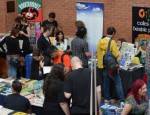






Really insiteful article on the p.o.v of the way self-publishers print.